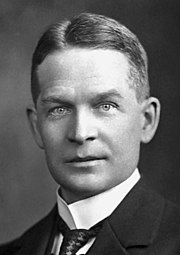Frederick Soddy | |
|---|---|
 Soddy in 1921 | |
| Born | 2 September 1877 |
| Died | 22 September 1956 (aged 79) Brighton, Sussex, England |
| Nationality | British |
| Alma mater | |
| Known for | |
| Spouse | Winifred Beilby[2] |
| Awards | |
| Scientific career | |
| Fields | |
| Institutions |
|
Frederick Soddy FRS[1] (2 September 1877 – 22 September 1956) was an English radiochemist who explained, with Ernest Rutherford, that radioactivity is due to the transmutation of elements, now known to involve nuclear reactions. He also proved the existence of isotopes of certain radioactive elements.[3][4][5] In 1921 he received the Nobel Prize in Chemistry "for his contributions to our knowledge of the chemistry of radioactive substances, and his investigations into the origin and nature of isotopes". Soddy was a polymath who mastered chemistry, nuclear physics, statistical mechanics, finance and economics.[6][7]
- ^ a b Fleck, A. (1957). "Frederick Soddy Born Eastbourne 2 September 1877 Died Brighton 26 September 1956". Biographical Memoirs of Fellows of the Royal Society. 3: 203–226. doi:10.1098/rsbm.1957.0014. JSTOR 769361.
- ^ Cite error: The named reference
Nobelwas invoked but never defined (see the help page). - ^ Davies, M. (1992). "Frederick Soddy: The scientist as prophet". Annals of Science. 49 (4): 351–367. doi:10.1080/00033799200200301.
- ^ Kauffman, G. B. (1997). "Book Review:The World Made New: Frederick Soddy, Science, Politics, and Environment Linda Merricks". Isis. 88 (3): 564–565. doi:10.1086/383825.
- ^ George B. Kauffman (1986). Frederick Soddy (1877–1956): Early Pioneer in Radiochemistry (Chemists and Chemistry). Dordrecht; Boston; Hingham: D. Reidel Pub. Co. p. 272. ISBN 978-90-277-1926-3.
- ^ Watson, Katherine D. (2007). "Soddy, Frederick (1877-1956)". Van Nostrand's Scientific Encyclopedia. doi:10.1002/0471743984.vse9748. ISBN 978-0471743989.
- ^ Davies, Mansel (1992). "Frederick Soddy: The scientist as prophet". Annals of Science. 49 (4): 351–367. doi:10.1080/00033799200200301. ISSN 0003-3790.